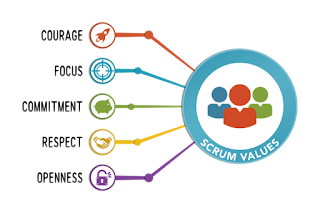This article is available at blog.scrum.org, here I just quote my favorite points and give my comment at the end of this post.
Ken Schwaber and Jeff Sutherland, the creators of Scrum delivered a webinar on their latest update to the Scrum Guide. The update was a simple one, adding the 5 values of Scrum to the Guide:
These values sound easy? Well, there are many misunderstandings and common problems when applying these values. Here are some example:
My comment:
I love the value "Focus" the most. I think it is worth the concern that we need to focus on Sprint goals. I just has experience with a project has too much unclear requirements (not really 100% unclear requirements but something like both our customers and our team don't know exact the scope what we are going to do) and limit release time. In some cases, we don't need make all things be perfect, just focus on the most valuable things and improve it later on. Therefore, the below mindset should be kept in mind:
[1]. https://blog.scrum.org/updates-scrum-guide-5-scrum-values-take-center-stage/
Ken Schwaber and Jeff Sutherland, the creators of Scrum delivered a webinar on their latest update to the Scrum Guide. The update was a simple one, adding the 5 values of Scrum to the Guide:
These values sound easy? Well, there are many misunderstandings and common problems when applying these values. Here are some example:
Value
|
Misunderstanding
|
Getting the value right
|
Commitment
|
Committing to something that you don’t understand because you are told to by your boss.
|
Committing yourself to the team and Sprint Goal.
|
Focus
|
Focusing on keeping the customer happy
|
Being focused on the sprint and its goal.
|
Openness
|
Telling everyone everything about all your work
|
Highlighting when you have challenges and problems that are stopping you from success
|
Respect
|
Thinking you are helping the team by being a hero
|
Helping people to learn the things that you are good at and not judging the things that others aren’t good at.
|
Courage
|
Even after the decision has been made continuing to push back
|
Being transparent, but willing to change even if that means accepting that you are wrong, or that your opinion is not the direction that the team is going.
|
My comment:
I love the value "Focus" the most. I think it is worth the concern that we need to focus on Sprint goals. I just has experience with a project has too much unclear requirements (not really 100% unclear requirements but something like both our customers and our team don't know exact the scope what we are going to do) and limit release time. In some cases, we don't need make all things be perfect, just focus on the most valuable things and improve it later on. Therefore, the below mindset should be kept in mind:
- Both $1 million house and $100 million house are house.
- Focus on 20% efforts to make 80% result.
[1]. https://blog.scrum.org/updates-scrum-guide-5-scrum-values-take-center-stage/

Comments
Post a Comment